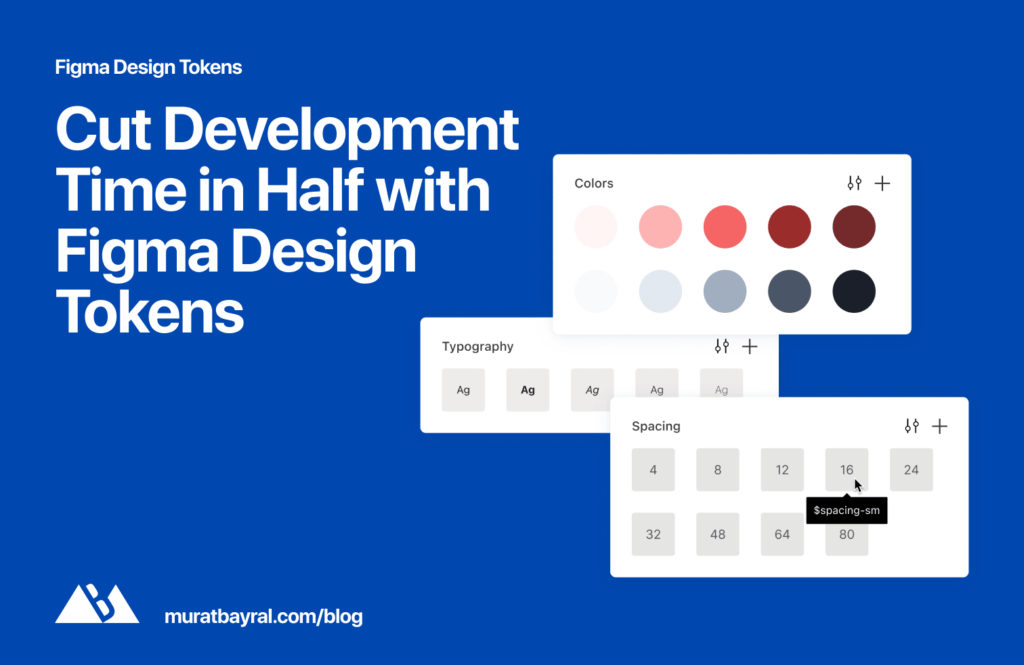The design landscape has changed dramatically over the past decade. While delivering great user experiences remains paramount, the process of design itself is increasingly focused on speed and collaboration. Agile workflows, design ops, and new tools like Figma have transformed UI design into a more iterative, cross-functional process. This is where Figma design tokens come into play as a breakthrough solution for streamlining modern UI design.

What Are Design Tokens?
Design tokens are visual style attributes like colors, typography, spacing, effects, etc. that are defined once and reused everywhere. By centralizing all your UI definitions into a “single source of truth”, design tokens enable much faster iteration and cross-platform consistency.
For example, you can define a core color palette as tokens with names like “Brand Blue” or “Secondary Gray”. These tokens can then be used throughout designs and code, ensuring everything stays in sync. If you later decide to tweak “Brand Blue”, the change propagates everywhere that token is used.
Key Benefits
Here are some of the top benefits of using design tokens in Figma:
Faster Prototyping
With your core UI styles defined upfront as tokens, you can quickly mock up designs without getting bogged down in repetitive styling work. Tweak the tokens as needed and changes flow through all linked designs. This rapid iteration is perfect for collaborative workflows like design sprints and agile development.
Cross-Platform Consistency
Design tokens make it simple to maintain a consistent UI across platforms. Define your tokens once in Figma, then export for any platform like iOS, web, Android etc. Visual consistency becomes effortless.
Improved Collaboration
Centralizing your UI style definitions enables better cross-functional collaboration. With everything linked to design tokens, there’s always a single source of truth when working across multiple designers and developers.
Future-Proof Design Systems
As products evolve, design tokens keep your UI system scalable. Update tokens in one place and changes propagate out, allowing you to refine designs over time. This “refactoring” capability lets you future-proof your design language. See my latest blog post about Figma Design System!
Dynamic and Responsive
You can make tokens dynamic, like setting a “font-size” to adjust based on screen size for responsive typography. Color tokens can also shift hue based on light/dark mode. This dynamism is only possible when styles are linked to design tokens.
Streamlined Developer Handoff
Design tokens enable a seamless handoff to developers. Teams can use the same token names, allowing devs to implement designs quicker and more accurately. Changes to tokens automatically flow rather than tossing new style specs over the wall. Check out Figma Youtube Channel for latest updates about design tokens and many more.
In summary, design tokens are revolutionizing UI design by optimizing for speed, scalability, and collaboration. They provide a single source of truth that powers more iterative workflows, reusable components, and a consistent user experience. Figma makes it easy to create and manage tokens across projects and teams. If you’re looking to maximize efficiency and collaboration in the design process, explore integrating design tokens into your workflow today!
Watch to learn more ↓
FAQ’s:
What are design tokens in Figma?
Design tokens are named UI style attributes like colors, fonts, spacing, etc that are defined once and reused across a project.
How does it enable rapid prototyping?
By centralizing styles into reusable tokens, designers can mockup interfaces faster without getting bogged down tweaking individual elements. This speeds up the iteration process.
How can it improve cross-platform consistency?
Design tokens enable you to export your UI styles into various platform-specific code formats. This allows mobile, web, etc to use the same tokens, ensuring visual consistency.
How do design tokens enhance collaboration?
With one centralized source for all UI styles, design tokens ensure all members of a team are using the same attributes. This syncs everyone up and reduces inconsistencies.
How can design tokens future-proof a design system?
Making design tokens dynamic allows them to adjust based on context like screen size. This flexibility enables the UI system to evolve over time.
What kinds of style attributes work as design tokens?
Any visual UI attributes can become design tokens – colors, fonts, text styles, effects, border radius, spacing, box shadow, etc.
How are design tokens different from styles in Figma?
Styles apply to specific elements whereas tokens are named for reuse across elements and screens.
Can design tokens be made dynamic and responsive?
Yes, advanced tokens can use formulas and constraints to make them adaptive. For example, sizing can adjust based on screen size.
What are some best practices for organizing design tokens?
Use clear naming conventions, structure tokens in a hierarchy, keep them in a single file, and use them consistently.
